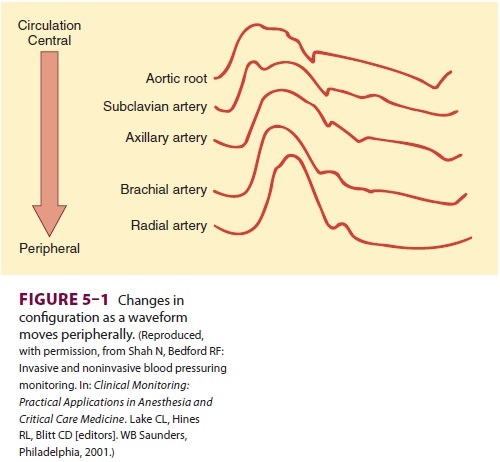Chapter: Clinical Anesthesiology: Anesthetic Equipment & Monitors : Cardiovascular Monitoring
Arterial Blood Pressure

ARTERIAL BLOOD PRESSURE
The rhythmic contraction of the left
ventricle, eject-ing blood into the vascular system, results in pulsa-tile
arterial pressures. The peak pressure generated during systolic contraction (in
the absence of aor-tic valve stenosis) approximates the systolic arterial blood
pressure (SBP); the lowest arterial pressure during diastolic relaxation is the
diastolic blood pressure (DBP). Pulse pressure is the difference between the
systolic and diastolic pressures. The time-weighted average of arterial
pressures during a pulse cycle is the mean
arterial pressure (MAP). MAP can be estimated by application of the
follow-ing formula:

Arterial blood pressure is greatly
affected by where the pressure is measured. As a pulse moves peripherally
through the arterial tree, wave reflec-tion distorts the pressure waveform,
leading to

an
exaggeration of systolic and pulse pressures (Figure
5–1). For example,
radial artery systolicpressure is usually greater than aortic systolic pres-sure
because of its more distal location. In contrast, radial artery systolic
pressures often underestimate more “central” pressures following hypothermic
cardiopulmonary bypass because of changes in hand vascular resistance.
Vasodilating drugs may accentuate this discrepancy. The level of the sam-pling
site relative to the heart affects the measure-ment of blood pressure because
of the effect of gravity ( Figure 5–2). In patients with severe
periph-eral vascular disease, there may be a significant dif-ference in blood
pressure measurements among the extremities. The higher value should be used in
these patients.

Because noninvasive (palpation, Doppler,
aus-cultation, oscillometry, plethysmography) and inva-sive (arterial
cannulation) methods of blood pressure determination differ greatly, they are
discussed separately.
Related Topics